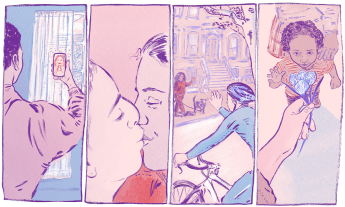
What’s the state of your relationships?
Are they strong and thriving? In need of a little attention or assistance? Or a bit of both, depending on the day, month or year?
Even good relationships tend to repeat the same routines over and over, so it may be a good time to try some new things. Even with your most positive relationships, some of your old habits, your old automatic ways of being and interacting that make the relationship less energizing, can sometimes resurface.
What follows are four strategies that we’ve found both in research and therapy to be effective in enlivening and energizing all of your relationships:
Suggestion #1: Feel the power of generosity
Relationships are necessarily reciprocal systems — support goes both ways. The support we receive is rarely an exact mirror image of the support we provide, but the old adage “you get what you give” is a good general rule.
This idea of giving what you’d like to receive in return is one answer to the powerlessness and hopelessness that people sometimes feel when they think of their relationships. We can’t directly control the way other people engage with us, but we can control the way we engage with them. We may not be receiving a certain kind of support, but that doesn’t mean we can’t give it.
The Dalai Lama reminds us that what goes around comes around:
“We are self-centered and selfish, but we need to be wisely selfish, not foolishly so. If we neglect others, we too lose. . . . We can educate people to understand that the best way to fulfill their own interest is to be concerned about the welfare of others. But this will take time.”
Research clearly shows that he’s right. Helping others benefits the one who helps. There is both a neural and a practical link between generosity and happiness. Being generous is a way to prime your brain for good feelings, and those good feelings in turn make us more likely to help others in the future. Generosity is an upward spiral.
Think honestly, and ask yourself: Do you provide to others the types of support you most want to receive? If so, to whom? Are there people in your life you want to support more? And if you have people in your life who are caring for others or who are experiencing a major life stress, are there ways you can be there for them, and make sure they are receiving support themselves?
As you look over your social universe, how does the balance of giving and receiving feel?
Suggestion #2: Practice radical curiosity
Curiosity — real, deep curiosity about what others are experiencing — goes a long way in important relationships. It opens up avenues of conversation and knowledge that we never knew were there. It helps others feel understood and appreciated. It’s important even in less significant relationships, where it can set a precedent of caring and increase the strength of new, fragile bonds.
Maybe you know someone in your life who is always talking to people, rooting out their stories and opinions. It’s no coincidence that these people are often very joyful and alive.
Bob (aka Robert Waldinger, one of the coauthors of the book that this is excerpted from) thinks of his father, who would talk to strangers everywhere. He was obsessively — radically — curious about everyone. Bob’s aunt and uncle often told a story about how they once got into a cab with him in Washington DC. Bob’s father sat in the front, as always, so he could talk to the driver. While he was extracting this man’s entire life story, he started playing with the quarter-glass window that used to be a feature in old cars.
He was so absorbed in the conversation that he didn’t realize the window had come off in his hand. Peals of laughter were coming from the backseat, but Bob’s father was too absorbed to notice. He set the little window on the seat beside him and started playing with the window crank, which also came off. He set that down, too, and just kept asking questions. Lucky for the car it was a short drive.
Bob’s father didn’t necessarily do it to be kind to people; he did it because it made him feel good. It energized him. Some of us are out of practice and have forgotten how this kind of curiosity can feel, so we have to be more deliberate. We have to take an almost radical approach to cultivating our natural interest in people, and take a bold step beyond our usual conversation habits.
We need to make a point to ask ourselves: Who is this person, really, and what’s their deal? Then it’s as simple as asking a question, listening to the reply, and seeing where it takes us.
The crucial point is that being curious helps us connect to others, and this connection makes us more engaged with life. Genuine curiosity invites people to share more of themselves with us, and this in turn helps us understand them. This process enlivens everyone involved. Even a small interest in another person, a brief word, can create new excitement, new avenues of connection, and new pathways for life to flow.
Suggestion #3: Communicating understanding back to others
When people hear that we, Bob and Marc, are therapists, they often react by saying something like, “How can you listen to other people’s problems all the time? That must be exhausting and depressing.”
It’s true that listening isn’t always easy, but the more prevalent and powerful experience for both of us is one of gratitude to the people we work with. We learn from their experience and it deepens our connection to them. One of our greatest joys — and this is not confined to therapy — comes in moments when we sense that we’ve understood the experience of another person and then communicated that understanding in a way that feels true to them. It’s life-affirming to suddenly find oneself in sync with the experience of someone else.
This is a crucial step in connecting with others through curiosity: communicating your new understanding back to them. Hearing an accurate rendition of our own experience coming from another person, articulated in their words, can be thrilling, especially when we’re feeling alienated in a social setting. Suddenly someone is seeing us as we are, and that experience momentarily breaches the barrier that we feel between us and the world. To be seen is an amazing thing.
Conversely, it’s an amazing thing to really see another person and to communicate what you see. The thrill of connection happens both for the person being seen and the person doing the seeing. Again, the connection and the feeling of vitality go both ways.
Suggestion #4: Do regular relationship check-ins
Regularly stepping back and taking stock of your relationships can help.If your social fitness is not where you would like it to be, you might want to do these reflective check-ins even more often. It never hurts — especially if you’ve been feeling low — to take a minute to reflect on how your relationships are faring and what you wish could be different about them.
If you’re the scheduling type, make it a regular thing; Perhaps every year on New Year’s Day or your birthday, take a few moments to draw up your current social universe (you can print out and fill out the chart on this page), and consider what you’re receiving, what you’re giving, and where you would like to be in another year. In 12 months, peek at it to see how things have changed. A lot can happen in a year.
If nothing else, doing this reminds us of what’s most important, and that’s always a good thing. When the participants in the Harvard Study of Adult Development, which we codirect, reached their 70s and 80s and were asked to look back on their lives, they would make a point to say that what they valued most were their relationships with friends and family.
If we accept the wisdom — and, more recently, the scientific evidence — that our relationships really are among our most valuable tools for sustaining health and happiness, then choosing to invest time and energy in them becomes vitally important. And an investment in our social fitness isn’t only an investment in our lives as they are now. It is an investment that will affect everything about how we live in the future.
Excerpted from the new book The Good Life: Lessons from the World’s Longest Scientific Study of Happiness by Robert Waldinger MD and Marc Schulz PhD, published by Simon & Schuster. Copyright © 2023 by Robert Waldinger and Marc Schulz. Reprinted courtesy of Simon & Schuster Inc.
To learn more, watch Dr. Robert Waldinger’s TED Membership conversation now.
TED Members help us meet our nonprofit mission to spread big ideas around the world; plus, they enjoy access to special events with speakers like these. Become a TED Member today.












